Exploring Fodder Feeding Systems in Agriculture
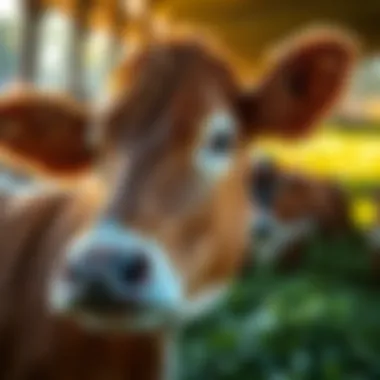

Intro
Agriculture is witnessing a dynamic transformation, particularly with the implementation of fodder feeding systems. These systems serve as the backbone for enhancing livestock productivity, optimizing their feeding strategies, and ensuring a sustainable future for farming practices. In a world where food security is critical, understanding and adapting these systems is paramount. The push for efficiency in agriculture does not involve just quantity but also quality—both in terms of the nutrients provided to livestock and the economic appeal for farmers. This article endeavors to unpack these multifaceted topics, providing insights into the latest trends, sustainable practices, and the nuances of effective fodder management.
Latest Trends in Agriculture
Overview of Current Trends
As the agricultural landscape evolves, new trends keep cropping up. Fodder feeding systems are not immune to these changes. In recent times, many farmers are shifting towards more integrated systems that employ hydroponics and aeroponics to grow fodder. Such methods can significantly reduce the amount of land and water required while increasing the nutritional density of the feed.
- Hydroponic systems enable the growth of fodder in water-based solutions, which enhances the rate of growth and minimizes wastage.
- Aeroponic systems take this a step further, allowing for the growth of plants in a mist environment, yielding faster results.
This multifaceted approach toward fodder is not only about efficiency and yield but also about securing a market that is increasingly leaning towards sustainability and innovation.
Impact of Technology on Farming Practices
Technological advancements have their fingerprints all over modern farming practices, including fodder management. Smart farming concepts have propagated the integration of data analytics and IoT solutions, providing farmers real-time feedback about the health of their crops and livestock. This data-driven approach assists farmers in making informed decisions about their fodder systems. For instance, with sensors to monitor soil moisture and nutrient levels, farmers can optimize irrigation and fertilization processes, leading to better yields and less wastage.
"Technology is not just a tool; it's a partner in modern agriculture, enabling farmers to achieve greater productivity and sustainability."
Sustainable Practices: Towards a Greener Future
Importance of Sustainability in Agriculture
In the quest for sustainable farming, the importance of fodder feeding systems cannot be overstated. These systems can play a pivotal role in diminishing the ecological footprint of farming. By implementing sustainable practices, such as crop rotation or intercropping, farmers can enhance soil health, improve biodiversity, and reduce chemical dependencies.
To illustrate, a mixed cropping system may include grasses and legumes, which not only enriches soil but also provides diverse feed for livestock, fostering a more resilient farming ecosystem.
Methods for Sustainable Farming
- Organic Farming: Utilizing natural fertilizers and pest control can lead to healthier fodder production, ultimately benefiting livestock.
- Permaculture: This holistic approach harnesses natural ecosystems for maximum productivity without detrimental effects.
- Agroforestry: Incorporating trees into fodder systems enhances biodiversity and offers additional resources for both livestock and soil health.
These methods not only fulfill the growing demand for sustainably-sourced food but also grant farmers the ability to maintain ecological balance while improving their livelihood.
Gardening Techniques and Tips
Essential Gardening Tools and Equipment
For gardening enthusiasts keen on establishing fodder systems, having the right tools can make all the difference. A well-equipped gardener should consider:
- Hand trowel: Ideal for digging and transplanting small plants.
- Pruning shears: Important for controlling plant growth and maintaining health.
- Compost bins: Utilizing kitchen waste for nutrient-packed compost that serves both gardens and livestock.
Seasonal Gardening Practices
Understanding seasonal changes can vastly improve the effectiveness of fodder production. During spring, sowing seeds for fast-growing grasses can prepare forage for peak livestock feeding during summer. Conversely, in autumn, preparing beds for winter fodder can ensure animals have continuous access to nourishment, even in colder months.
By being mindful of these seasonal dynamics and engaging with sustainable practices in both agricultural and gardening frameworks, farmers and enthusiasts alike can venture towards a productive and eco-friendly future.
Understanding Fodder Feeding Systems
Fodder feeding systems are not just a trend; they are an essential component of modern agriculture. These systems provide vital nutrition for livestock, and managing them effectively can ultimately improve overall productivity in farming operations. With the growing demand for sustainable farming practices, understanding fodder systems becomes pivotal. They offer numerous benefits, such as optimizing space, utilizing resources efficiently, and enhancing the health of animals, which in turn benefits the farmers.
Definition and Overview
Fodder feeding systems refer to various methods employed to cultivate and provide feed for livestock. These methods can range from traditional pasture grazing to advanced hydroponic systems. In simple terms, fodder is any plant matter that livestock eat, and its provision varies based on locality, climate, and farming practices. Let’s paint a clearer picture.
For instance, hydroponic systems grow fodder without soil, using nutrient-rich water instead. On the other hand, traditional methods involve growing grass or legumes on pasture land. Each method has its unique set of advantages and limitations. Simply put, these systems cater to livestock needs while aiming to maximize feed growth and nutritional content.
Historical Context
The concept of fodder feeding systems is not a new one. The roots can be traced back centuries to when ancient farmers first recognized the importance of cultivating plant material to sustain their livestock. Over time, feeding practices evolved, adapting to advances in agriculture and changes in societal demands.
In ancient civilizations, like Mesopotamia and Egypt, livestock were primarily grazed on natural pastures. This method served its purpose, yet was limited by seasonal changes and available land. The introduction of crop rotation and selective breeding techniques marked significant strides in fodder cultivation.
Fast forward to the 20th century, the introduction of fertilizers and synthetic feed revolutionized the industry. Farmers shifted toward growing crops specifically for animal feed due to the higher yields and efficiency. Today, modern systems like aeroponics further illustrate the journey of fodder cultivation, embracing technology as a key element.
Types of Fodder Feeding Systems
Understanding the diverse types of fodder feeding systems is crucial for modern agriculture. Each method contributes differently to livestock management and sustainability. By exploring hydroponic, aeroponic, and traditional pasture systems, we can grasp their unique characteristics, benefits, and challenges.
Hydroponic Fodder Systems
Hydroponic fodder systems use nutrient-rich water to grow plants without soil. This method is gaining traction for its efficiency and resource conservation. In hydroponics, cereals like barley are typically sprouted in a controlled environment, allowing them to grow in just a week. The significance of this system lies in its potential to produce high-quality fodder in limited space. Hydroponic systems require careful management of water and nutrients; thus, farmers need to monitor parameters closely.
One of the big advantages of hydroponics is that it minimizes land use. In regions where arable land is scarce, this can help bridge the gap for feed production. Furthermore, hydroponic fodder is often fresher and more nutritious than conventional feed.
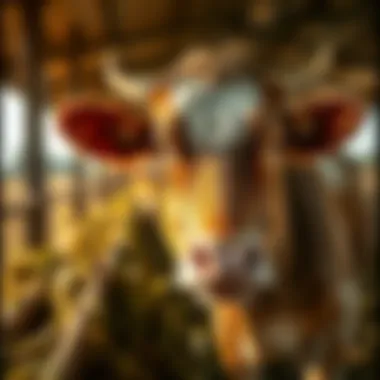
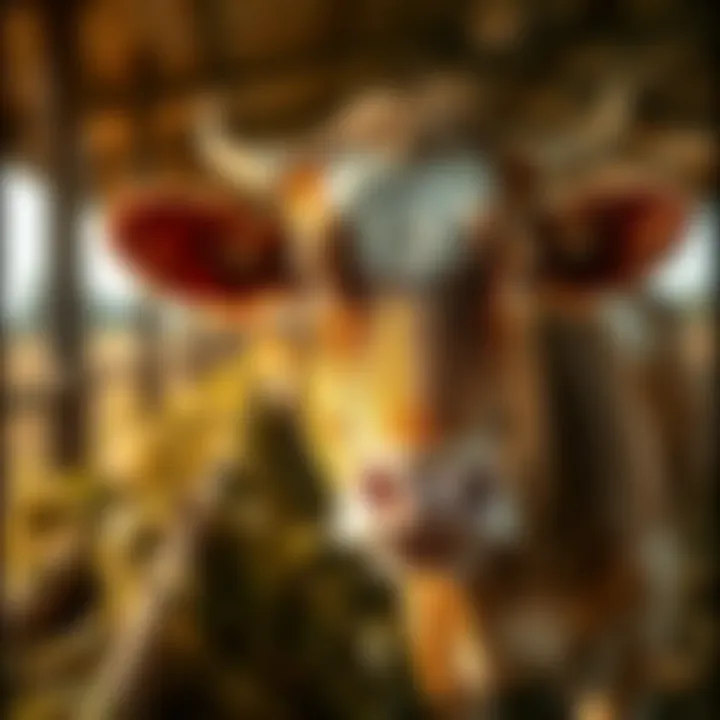
Another point to consider is the energy input. While hydroponic systems save water, they often require electricity to maintain optimal growing conditions. This factor can affect overall sustainability. However, the payoff can be higher livestock productivity and health due to superior quality feed.
Aeroponic Systems
Aeroponic systems take it a step further by suspending plants in air and misting them with nutrient solutions. This method not only enhances growth rate but also maximizes the use of space. In aeroponics, roots are exposed to both oxygen and nutrients simultaneously.
These systems are particularly beneficial in urban settings or where traditional feed methods are infeasible. The efficiency of aeroponics promotes a faster harvest cycle, allowing farmers to produce fodder more frequently. Plus, the reduced risk of soil-borne diseases adds another layer of practicality.
However, maintaining microclimates in aeroponic systems can be a tricky endeavor. These systems rely heavily on technology, which may require significant investment. Thus, it’s suitable for farmers willing to embrace innovative farming practices.
Traditional Pasture Systems
While modern methods capture attention, we cannot overlook traditional pasture systems. They have been the backbone of livestock feeding for centuries. Pasture systems allow animals to graze naturally, promoting behavior that is innate to them. This method aligns with animal welfare principles, as it provides livestock with fresh air and forage, which is crucial for their overall health.
Nonetheless, this system faces challenges like seasonal availability and land degradation. In arid regions or areas with unpredictable weather patterns, relying solely on pasture may not suffice. To mitigate these issues, integrating traditional methods with newer systems can offer a hybrid approach, paving the way for innovation in fodder production.
Therefore, understanding the strengths and limitations of each fodder feeding system can lead farmers to choose methods that best suit their operational goals and regional characteristics. As we look ahead to future trends, staying informed about these types will allow for more informed decisions in livestock feeding.
Components of Fodder Feeding Systems
In the realm of fodder feeding systems, understanding the various components is essential. It’s not just about the feed itself; it encompasses a wider array of elements that together create an efficient and sustainable feeding system. Think of it like constructing a house—without the right foundation and materials, the entire structure could crumble. Therefore, every facet of fodder feeding systems contributes to the overall success of livestock health and productivity.
Equipment and Infrastructure
The backbone of any fodder feeding system is its equipment and infrastructure. Modern systems may utilize specialized machinery that ensures the quality and consistency of fodder production. For instance, hydroponic systems require trays, a nutrient solution reservoir, and lighting. Each piece of equipment has a role to play in optimizing growth.
- Hydroponic Trays: These serve as the growing beds. When selecting trays, one must consider drainage and mildew resistance.
- Lighting Systems: Adequate light is crucial for photosynthesis. LED grow lights have become popular due to their energy efficiency.
- Nutrient Delivery Systems: Automated nutrient delivery ensures plants receive the right amount of water and fertilizers.
It's imperative to invest in durable and suitable equipment. Neglecting to do so can lead to inefficiencies, increased operational costs, and possibly a detrimental impact on your livestock's nutrition.
Water Management
Water is life, especially in feeding systems where crops must thrive and livestock hydrated. Effective water management is a cornerstone to a successful fodder production system. Improper water use can result in nutrient leaching or, conversely, waterlogging, which can be harmful to plant roots.
- Systematic Irrigation: Employing precise irrigation methods—like drip irrigation—ensures that water goes directly to where it's needed most, reducing waste.
- Water Quality Testing: Regular testing helps ascertain if the water is free from contaminants. Poor water quality can negatively affect livestock health and crop yields.
- Conservation Practices: Capturing rainwater or recycling water from other processes are wise practices that reduce costs and promote sustainability.
The right approach to water management not only enhances crop yield but also conserves a precious resource, aligning with modern agriculture's sustainable practices.
Nutritional Additives
The efficacy of fodder feeding systems isn’t just determined by the type of fodder grown; it's also about what goes into that fodder. Nutritional additives play a pivotal role in enhancing the feed's quality and meeting the specific dietary requirements of livestock. Major concerns that farmers must consider include nutrient balance and feed palatability.
- Mineral Supplements: Essential minerals such as calcium and phosphorus ensure the overall health of the livestock.
- Probiotics: These beneficial bacteria enhance gut health and improve digestion, leading to better feed conversion rates.
- Organic Additives: Ingredients such as seaweed or natural herbs can boost immunity and provide additional nutrients.
Integrating proper additives into the system is key to better livestock productivity. It's crucial to tailor these additives to the specific needs of the animals being fed. An unbalanced diet can lead to numerous health issues and ultimately, a reduction in overall productivity.
"An effective fodder feeding system doesn’t just feed livestock; it nurtures a future where agriculture can sustain itself without compromising quality."
With keen attention to components like equipment, water management, and nutritional additives, farmers can harness the full potential of fodder feeding systems, ensuring their livestock is not only well-fed but also thrives in a sustainably managed environment.
Advantages of Implementing Fodder Feeding Systems
The adoption of fodder feeding systems delivers a range of advantages that can significantly enhance the agricultural landscape. From improving livestock health to fostering sustainable practices, these systems are increasingly relevant in modern farming. Understanding these benefits not only helps farmers maximize productivity but also contributes to the broader aim of responsible and sustainable agriculture.
Improved Livestock Health
Fodder feeding systems, such as hydroponic and aeroponic setups, provide livestock with superior nutrition. These systems offer fresh and nutrient-rich fodder, which can lead to marked improvements in health and overall growth rates. Studies indicate that animals fed fresh fodder tend to exhibit lower incidences of diseases and disorders. The quality of feed has been linked to important parameters like milk production in dairy cows and growth in meat animals. When livestock consumes high-quality fodder, they absorb essential vitamins, minerals, and proteins, which contribute to their vitality and immune response.
Moreover, better nutrition translates to enhanced reproductive performance. Healthy animals breed better, which is crucial for livestock operations aiming to expand or improve their genetic stock. It’s a clear win-win situation, where well-nourished animals lead to better productivity.
Enhanced Feed Efficiency
Implementing advanced fodder systems allows farmers to maximize feed efficiency, an aspect vital to the success of any agricultural operation. Feed efficiency measures how well livestock convert feed into desired products such as milk, meat, and eggs. When using traditional feed sources, variations in quality and availability can directly affect this efficiency. In contrast, fodder systems enable consistent, high-quality feed year-round.
This increased feed conversion rate results not only in reduced costs but also improves the overall economic viability of livestock production. By feeding livestock nutritionally balanced and palatable fodder, farmers can expect to see quicker weight gain in animals, shorter calving intervals, and higher yields. For example:
- Cattle consume less feed to gain more weight.
- Poultry benefit from improved egg production.
Fodder feeding systems help in shrinking the carbon footprint of farming by reducing the need for extensive land usage for traditional feed crops. Moreover, the efficient use of resources can translate into greater profit margins for producers.
Sustainable Practices
Sustainability is a growing concern in agriculture, and fodder feeding systems align closely with agricultural objectives aimed at reducing environmental impacts. These systems often use less water than traditional farming methods for growing feed crops. Hydroponics, in particular, demonstrates several sustainable practices, such as the ability to grow without soil and using water recirculation techniques that minimize waste.
Furthermore, fodder production can take place in less-than-ideal environments, allowing regions with limited arable land to still produce livestock feed effectively. This adaptability can help reduce the pressure on land resources, enabling areas to maintain ecological balance.
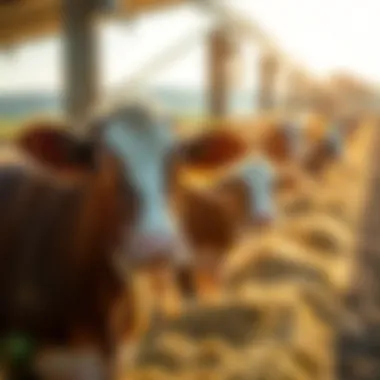
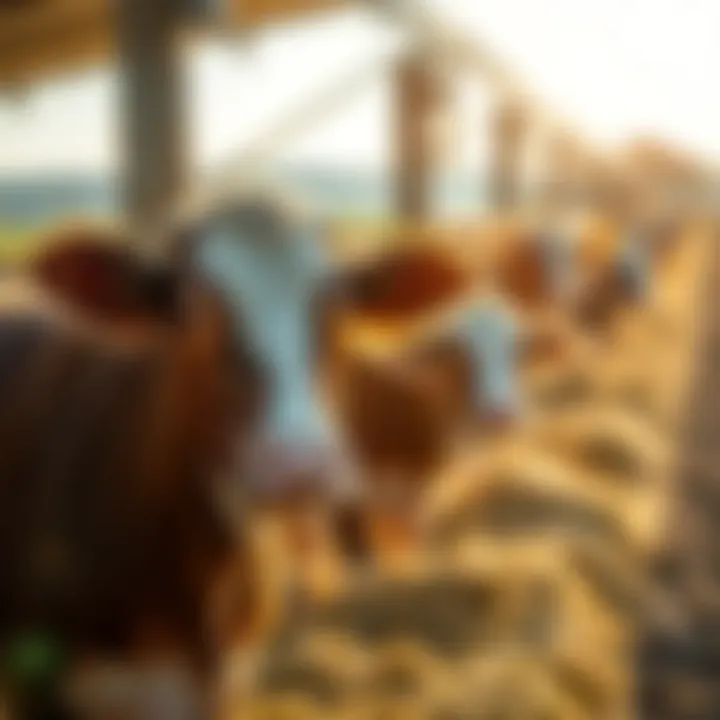
- Reduced need for pesticides and herbicides is another perk, as controlled environments allow farmers to rely more on natural pest deterrents.
- The cultivation techniques used in fodder systems can enhance soil health when conducted after traditional farming cycles, as they often involve minimal soil disturbance.
Overall, by implementing innovative fodder feeding systems, farmers not only boost productivity but also engage in practices that contribute positively towards sustaining the environment for future generations.
"The shift towards fodder feeding systems marks a significant step in creating resilience within agriculture, promoting both animal welfare and environmental stewardship."
Integrating these systems into farming operations is becoming a critical consideration for farmers aiming to thrive in a rapidly evolving landscape.
Challenges in Fodder Feeding Systems
Fodder feeding systems, while highly beneficial, are not without their share of hurdles. Understanding these challenges is crucial for farmers and enthusiasts alike, as it allows them to make informed decisions when it comes to adopting newer practices. The landscape of agriculture is ever-evolving, and one wrong move can mean the difference between thriving livestock and a struggling farm. Below, we delve into three primary challenges that can complicate the implementation of fodder feeding systems: economic constraints, technological limitations, and environmental impacts.
Economic Constraints
Many farmers consider economic factors before diving into advanced fodder feeding solutions. The initial investment for systems such as hydroponics or aeroponics can be quite steep. Equipment, infrastructure, and ongoing operational costs contribute to an existing strain on budgets. For instance, costs associated with specialized containers and nutrient solutions can add up quickly for a small-scale farmer.
Farmers are often faced with the dilemma of balancing their current economic state against the perceived long-term benefits of these systems. If a system promises better productivity but requires substantial upfront cash, the decision-making process can become fraught with uncertainty. Financing options may be available, yet the complexity involved in securing agricultural loans can deter many from pursuing their desired systems.
Key Financial Considerations:
- Initial Setup Costs: The price ranges can vary based on equipment quality.
- Operational Expenses: Regular maintenance and nutrient input can accumulate over time.
- Return on Investment (ROI): Understanding when one might expect to see profits is essential.
Technological Limitations
Another significant challenge lies within technological constraints. While innovations in fodder feeding systems are promising, not all farmers have the access or knowledge to implement high-tech solutions effectively. For example, sophisticated automation systems require not only advanced machinery but also the expertise to manage them.
Farmers using traditional methods may be hesitant to embrace technology. This apprehension can stem from a lack of exposure to modern systems or concerns about relying on technology for critical livestock needs. Additionally, maintaining and troubleshooting elaborate systems can be daunting, leading to interruptions that can severely affect livestock productivity.
Common Tech-Related Obstacles:
- Lack of Training: Many farmers do not receive adequate tech training.
- Dependency on Tech: Failure of equipment can lead to immediate challenges.
- Integrating New Tech: Blending new and old systems can be problematic.
Environmental Impacts
Fodder feeding systems should ideally contribute positively to the environment, but unintended consequences can occur. Practices that significantly alter water usage or land management can result in adverse environmental impacts. For example, excessive water use in hydroponic systems can deplete local resources, leading to criticism from environmental advocates and local communities.
Furthermore, growing crops for fodder in areas unsuitable for cultivation can lead to soil degradation. This degradation not only compromises the sustainability of the farming practice but can also lead to broader ecological issues, such as biodiversity loss. It is paramount that farmers are aware of the balance between productivity and environmental stewardship.
Noteworthy Environmental Factors:
- Water Usage: How water-efficient is the system in use?
- Soil Management: The long-term health of the soil should be a priority.
- Biodiversity: Are farming practices harming local ecosystems?
"Farmers must keep one eye on productivity and the other on stewardship. The road to sustainability is often paved with choices that can have lasting ecological footprints."
In summation, while the benefits of implementing fodder feeding systems are numerous, the challenges are equally noteworthy. Understanding these elements thoroughly ensures that farmers can navigate the complexities of modern agriculture with better preparedness. Tools like improved training programs and financial options may emerge to alleviate some of these challenges, but recognizing the potential pitfalls is the first step towards sustainable fodder management.
For further reading on sustainable agriculture, you might check out resources from USDA and Farmer's Almanac.
Case Studies of Successful Implementation
When considering the effectiveness of fodder feeding systems, it becomes evident that real-world examples provide invaluable insights. Case studies of successful implementation not only underscore the practical applicability of these systems but also illuminate their diverse benefits, shedding light on the considerations that can drive their adoption across varied backgrounds in agriculture.
By examining specific instances where fodder feeding systems have been effectively utilized, we can draw a blueprint for other farmers and enthusiasts who may be contemplating similar ventures. These case studies typically illustrate triumphs in productivity, livestock health, and environmental sustainability, ultimately encouraging a shift towards modern, resilient agricultural practices.
Moreover, such instances aid in building a community of knowledge, empowering farmers with the anecdotal evidence they need to make informed decisions about integrating new systems into their operations.
Commercial Fodder Production
One of the most compelling examples of commercial fodder production can be observed in large-scale operations that have effectively utilized hydroponic systems. For example, one innovative company in California has perfected the art of growing barley sprouts in controlled environments. By optimizing conditions such as light, temperature, and nutrient availability, they can produce substantial quantities of nutritious fodder year-round.
This operation serves not just local dairy farms but has garnered attention from distant producers looking to reduce their feed costs and improve livestock performance. The economic benefits are profound:
- Their hydroponically grown feed has shown to increase milk production by up to 30% in treated dairy cattle.
- Waste reduction practices have been prioritized, turning excess water from the system into irrigation for surrounding crops, truly marrying sustainability with productivity.
- The scalability of their model allows for flexible expansions, aiding many in adapting as demands shift.
This case study provides a formidable argument for the economic advantages of commercial fodder production, demonstrating that investing in modern systems can lead to substantial returns while addressing food security issues directly.
Small-Scale Operations
Contrasting the commercial landscape, small-scale operations also exhibit successful instances of fodder feeding systems in action. A notable case comes from a family-run farm in New York that embraced vertical farming techniques to cultivate microgreens for livestock. This initiative stemmed from a desire to enhance the self-sufficiency of their homestead while reducing dependency on external feed sources.
Their small, yet efficient, setup allows them to:
- Produce high-quality fodder daily, even in winter months, thus fully utilizing their greenhouse.
- Experiment with different combinations of seeds, ensuring that the livestock receives varied nutrients; this includes using legumes alongside other grains.
- Demonstrate that small operations can indeed reap the benefits of modern practices without extensive investments.
This example reflects not only the practicality of fodder systems for smaller farms but also a growing movement towards self-sustained agricultural practices.
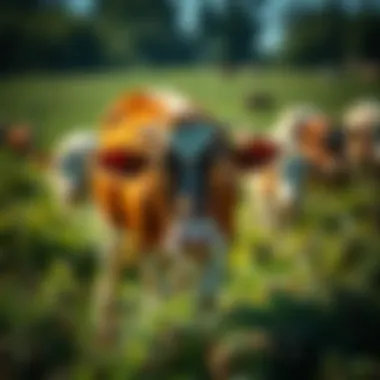
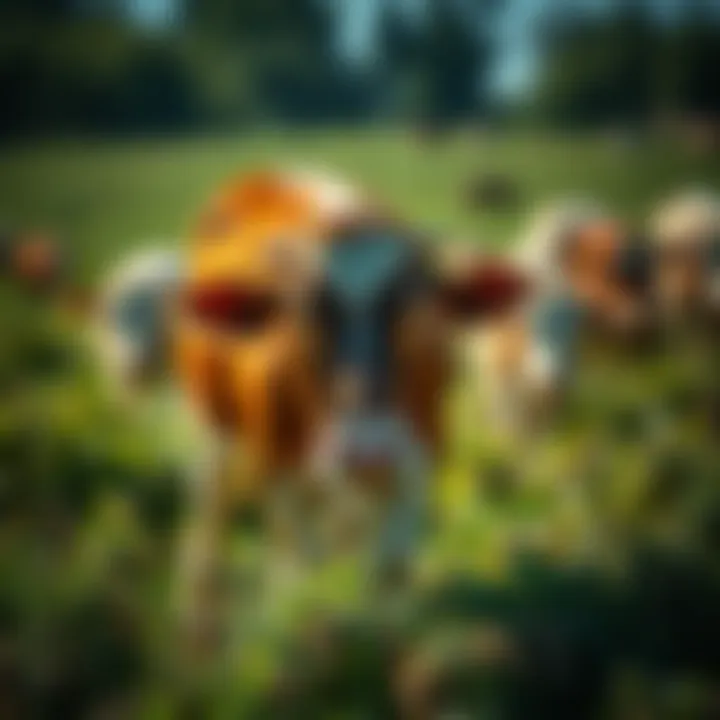
Successful case studies, whether large or small, serve as a compass for the future of fodder feeding systems, showcasing practical effectiveness in improving productivity and offering sustainable solutions to current challenges in agriculture. As such, they set benchmarks that can guide emerging farmers aiming to make their mark in an evolving industry.
Future Trends in Fodder Feeding Systems
As agriculture continues to evolve, the methods we employ to feed livestock must also progress. The future of fodder feeding systems showcases a blend of innovation and sustainability. As pressures like climate change and population growth mount, understanding these trends becomes crucial for farmers and agricultural enthusiasts alike. By adopting modern techniques, producers can ensure that they are prepared to meet future challenges head-on while also enhancing productivity and ecological balance.
Integrating Technology and Automation
The landscape of farming is rapidly changing with the advent of technology. Integrating technology and automation into fodder feeding systems presents a wealth of opportunities. For one, using sensors and IoT devices can optimize water usage and nutrient delivery. This tech not only makes operations more efficient but also reduces waste, which is essential in an era where resources are becoming scarce.
Think of automated systems that monitor moisture levels or nutrient concentrations in real time. These advancements mean that farmers can tailor their fodder production to exacting specifications, ensuring optimum conditions for plant growth.
Moreover, robotics is making its mark. Automated harvesters can significantly reduce labor costs and increase output. They take the grunt work out of feeding systems, allowing farmers to focus on better management strategies and livestock health.
An example of technology integration is precision agriculture tools that allow visualization of soil and crop health. When these insights drive fodder production decisions, it can lead to healthier crops and thus healthier livestock.
"It's not just about growing food; it's about growing it smarter."
Genetic Advances in Forage Crops
The genetic advancements in forage crops are nothing short of remarkable. Breeders are harnessing biotechnology to enhance the nutritional profile of fodder crops. By developing varieties that resist pests and diseases, they minimize the need for chemical interventions. This is significant for farmers looking to adopt sustainable practices while also maintaining productivity.
These improved varieties often have enhanced digestibility, enabling livestock to get more nutrients from the same amount of feed. Some innovations even focus on drought resistance, which helps farmers face climate variability without compromising their fodder supply.
Furthermore, genetic modification and selective breeding can lead to increased yield per hectare, drastically reducing the land required for fodder production. This ensures that more natural habitats remain protected, helping maintain biodiversity in agricultural regions.
Just as important, efforts are underway to develop forage crops that can thrive in various soil types and conditions, providing farmers with adaptable choices to suit their specific environments. As these technologies and methodologies continue to mature, the positive effects on both productivity and the environment should become increasingly apparent.
Regulatory and Safety Considerations
In the realm of fodder feeding systems, adhering to regulatory and safety considerations is not merely a compliance formality but a crucial measure that directly impacts both the health of livestock and the preservation of the environment. As farmers and agricultural enthusiasts venture into implementing various fodder systems, understanding the myriad regulations can enhance their operational efficiency while safeguarding their investments.
Food Safety Standards
Food safety standards play a pivotal role in ensuring that the fodder provided to livestock is free from contaminants and safe for consumption. These guidelines are set by various regulatory bodies to protect animal health as well as food safety for the end consumer. Here are some key points regarding food safety standards:
- Traceability: Farmers must document and track the sourcing of their fodder, ensuring it meets health regulations.
- Quality Control: Regular testing for microbial contamination and pesticide residues is a fundamental aspect to uphold livestock health.
- Labeling: In compliance with regulations, it's pertinent to have clear labeling of fodder inputs, especially for those using additives or supplements.
For instance, guidelines set by organizations such as the Food and Drug Administration (FDA) and the American Association of Feed Control Officials (AAFCO) can offer frameworks that farms should align with to ensure adherence to food safety practices. Farmers looking to deepen their knowledge can find valuable resources on websites like FDA and AAFCO.
"Understanding food safety standards is not just about compliance; it's about building trust with consumers and enhancing the quality of livestock".
Environmental Regulations
Equally important are environmental regulations, which govern the sustainable practices surrounding fodder feeding systems. These rules help mitigate negative impacts on the ecosystem while promoting responsible usage of resources. Here are aspects to consider:
- Water Usage: Regulations often stipulate guidelines for the efficient use of water resources in fodder production, crucial in regions facing water scarcity.
- Waste Management: Proper disposal and recycling of waste materials from fodder operations can reduce environmental footprints and adhere to local waste management policies.
- Pesticide and Fertilizer Use: Compliance with regulations on the type and quantity of agricultural inputs can help prevent soil and waterway contamination.
By mastering environmental regulations, farmers not only contribute to ecological balance but also position themselves favorably in an increasingly eco-conscious market. Resources found on governmental sites like EPA can provide comprehensive guidelines on environmental stewardship in agriculture.
Education and Awareness
Education and awareness have grown to be pivotal elements in the realm of fodder feeding systems. As agriculture continues to embrace new methods driven by innovation, a solid understanding of these systems enables farmers and agricultural enthusiasts to optimize results. Knowledge is power, especially when it comes to improving livestock health and boosting productivity. Familiarity with fodder systems equips individuals with valuable skills and insights to leverage these practices in their operations effectively.
Training for Farmers
Training programs focused on fodder feeding systems serve as the backbone of agricultural education. Such training not only covers the technical aspects of different systems but also emphasizes best practices in cultivation and feeding strategies. Here’s why it matters:
- Skill Enhancement: Farmers gain hands-on experience in managing fodder production, which can lead to significant improvements in crop yield and animal health.
- Problem-Solving: With targeted training, farmers learn how to troubleshoot common issues related to water management, pest control, or nutrient deficiencies in fodder crops.
- Resource Efficiency: Training helps to maximize resource use, minimizing waste while optimizing water and nutrient inputs.
- Networking Opportunities: Engagement in training allows farmers to connect with peers and experts, fostering a community of practice that facilitates sharing of knowledge and experiences.
For instance, farmers attending workshops on hydroponic fodder systems may participate in interactive demonstrations and discussions. These experiences empower participants to adopt methodologies that suit their specific environmental and operational contexts.
Community Initiatives
Community initiatives play a crucial role in disseminating knowledge about fodder feeding systems. Such programs often aim to bridge the gap between advanced agricultural practices and the grassroots level. Here’s how they make a difference:
- Localized Knowledge: Initiatives tailor educational content to the unique challenges faced by farmers in a particular region, ensuring that information is relevant and actionable.
- Collaborative Learning: These efforts often promote collective learning and sharing of resources, where communities may come together to share experiences and success stories.
- Support Systems: Establishing a network for ongoing support can be hugely beneficial. Whether it's through mentorship programs or local farmer cooperatives, community initiatives encourage continuous improvement.
Finale
Summary of Key Points
Fodder feeding systems play a pivotal role in modern agriculture, addressing numerous challenges faced by livestock producers today. This comprehensive examination reveals that the inclination towards sustainable feeding practices is not just a trend; it’s a necessity. Key points discussed in the previous sections include:
- Types of Feeding Systems: Systems such as hydroponics and traditional pasturing each come with distinct advantages and challenges, tailored to the specific needs of farmers.
- Components and Infrastructure: The importance of appropriate equipment, effective water management, and nutritional additives can't be overstated; they form the backbone of achieving optimal livestock health and productivity.
- Advantages and Benefits: Improved livestock health, better feed efficiency, and environmental sustainability are primary benefits that arise from adopting these systems.
- Challenges: Economic constraints and technological limitations must be navigated to maximize the benefits offered by fodder systems, underscoring the need for innovative solutions.
- Future Outlook: Trends include integrating technology and genetic advancements in crops, suggesting a forward-thinking approach to fodder management.
Final Thoughts on Future Directions
Looking ahead, the evolution of fodder feeding systems appears poised for further growth and innovation. As farmers navigate environmental challenges and strive for enhanced outputs, a keen focus on integrating technology into traditional practices will likely be paramount. Automation, precision agriculture, and enhanced communication tools will not just improve efficiency but also help in making informed decisions based on real-time data.
Furthermore, educating the farming community through targeted workshops and initiatives can bridge gaps in knowledge and implementation strategies. By embracing these future directions, the agriculture sector can enhance livestock productivity while preserving ecological integrity. The dynamic relationship between agricultural practices and technology heralds a new era for fodder systems, demonstrating that the future could yield not only sustainability but also resilience in the face of global changes.
"Innovation in fodder systems is not just about feeding animals; it’s about rethinking how we interact with our environment and resources."







